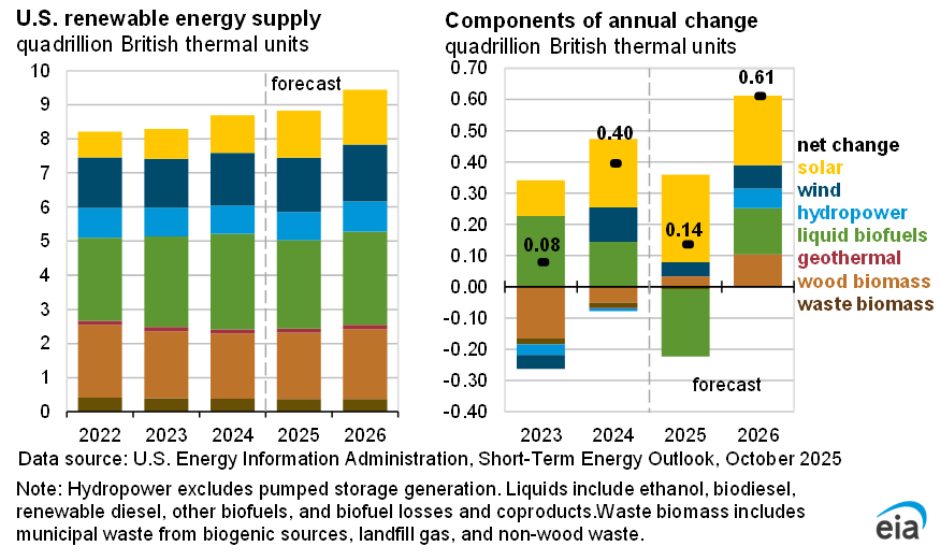The U.S. electricity sector is on track for steady growth in 2025, with total electricity generation from all sources projected to exceed 4,400 billion kilowatthours (BkWh) — a 2 percent increase year-over-year.
Utility-scale renewable energy, including conventional hydropower, is expected to grow 9 percent in 2025, surpassing 1,000 BkWh of generation, the U.S. Energy Information Administration (EIA) said in its forecast report. This figure excludes contributions from small-scale solar systems, which are also expanding rapidly.
Renewable Energy Leading Growth
Small-scale solar capacity continues to drive the growth of U.S. renewable energy. In 2025, small-scale solar is forecast to contribute over 90 BkWh, increasing to almost 110 BkWh in 2026. Monthly data show that total solar generation, combining both utility-scale and small-scale sources, first surpassed wind generation in July and August 2024. In 2025 and 2026, solar electricity supply is expected to exceed wind generation from May through September each year.
Overall, total solar electricity generation is projected at 380 BkWh in 2025 (including small-scale solar), while wind energy is expected to generate 470 BkWh. By 2026, solar output is forecast to increase by 17 percent, approaching 450 BkWh, while wind generation is projected to reach 490 BkWh, a 5 percent increase from 2025.
Growth of Small-Scale Solar Capacity
The majority of small-scale solar, defined as systems under 1 megawatt (MW), comes from residential rooftops. In 2025, 68 percent of small-scale solar capacity will originate from residential installations. Total small-scale solar capacity is expected to reach 60 GW in 2025 and 67 GW in 2026, signaling continued growth in distributed solar generation.
Coal Consumption Trends
The U.S. electric power sector experienced higher coal usage in 1H25, consuming 199 million short tons (MMst)—a 15 percent increase from 1H24. This rise was driven by stronger electricity demand and higher natural gas prices, which made coal more competitive. During the colder winter months, especially January 2025 in the Southeast, increased electricity demand for heating further boosted coal-fired generation.
The average natural gas price delivered to electric generators in 1H25 was $4.17/MMBtu, 46 percent higher than the same period in 2024. Prices are forecast to average $3.40/MMBtu in 2H25, still 27 percent above the previous year.
In 2026, coal consumption in the power sector is expected to decline slightly to 390 MMst, roughly 3 percent lower than 2025, due to increased generation from new utility-scale solar facilities, particularly in the Midwest. The planned retirement of about 4 percent of existing coal-fired capacity by the end of 2025 also contributes to lower projected coal use. However, recent Department of Energy investments in coal may affect retirement decisions and future coal generation.
Key Takeaways
Total U.S. electricity generation in 2025 is expected to exceed 4,400 BkWh, driven by renewable growth.
Utility-scale renewables will generate over 1,000 BkWh, with solar surpassing wind generation in summer months.
Small-scale solar capacity continues to expand, with residential rooftops leading the growth.
Coal consumption rose in early 2025 due to cold weather and high natural gas prices but is expected to decline in 2026.
The U.S. power sector is navigating a transition toward renewable energy, balancing growing solar and wind generation with traditional coal and natural gas sources to meet rising electricity demand in 2025–2026.
Baburajan Kizhakedath

